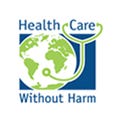Walking the Walk:
Our Divestment Journey
We’re not a fan of fossil fuels. So we decided to get rid of them. Veronique Nagle, our Human Resources Director, shares the motivation and difficulties that come with divesting an organization from its fossil fuel holdings
Inspired. Proud. Thankful. That was my immediate reaction when I was asked to take on the challenge of divesting Health Care Without Harm and Practice Greenhealth from our fossil fuel investments.
But it was also a daunting task. Divesting meant we needed to transition our employee retirement plan to one that was completely free of fossil fuel investments. I was impressed with our decision to do this and honestly, a bit overwhelmed.
As part of our Climate and Health campaign, we encourage health systems to do this very thing — to demonstrate climate leadership by divesting their fossil fuel holdings, creating fossil fuel-free retirement funds for employees, and investing in alternative energy and clean technology.
Beyond our dedication to our mission, we have a responsibility to practice what we preach. So began our journey to find a new employee retirement solution that we could use to “walk the walk”.
Like any journey, this one had its uphill challenges. Where do we start? Are we asking the right questions? How do we select the right vendor? What green options are available? What happens if fossil fuels are introduced into an originally fossil fuel-free fund? All of these questions — and many more — had to be asked and answered throughout the process.
Once we made the decision to divest, it took us a little over a year to finally complete the transition. We started by reaching out to a few connections we had, and we then spent most of that year doing our due diligence on prospective financial advisors, fund managers, and the funds themselves.
For a small organization like ours, it was a challenge at times understanding the retirement fund process as a whole as well as the players involved. We had lots of conversations and questions. But after finding Green Retirement, a financial advisory firm specializing in environmental stewardship and social responsibility, our path became clear.
An Achievable Goal
Despite the challenges, the question shouldn’t be whether or not your organization should divest from fossil fuels. Instead, your focus should be “How can we do this with the best interest of our organization and its employees in mind?” As an HR professional, I have seen firsthand how this change makes good business sense for an organization and its employees.
Climate change impacts everyone
There’s a reason the Lancet calls climate change the greatest global health threat of the 21st century. Climate change impacts the health of your customers, patients, and employees, not to mention your families, friends, and communities. Fossil fuels are the primary driver of climate change and every action we take to reduce the burden of fossil fuels will create opportunities for everyone worldwide to live healthy, productive lives.
Employees need to trust an organization’s leadership
Trust in leadership is built through actions. This change in your retirement fund planning not only aligns your organizational operations with your mission, but it also provides an opportunity for employees to create greater individual impact. When our transition was unveiled, we received an outpouring of support and appreciation from staff. And because our organizations walk the walk, we are able to attract really talented people who are passionate about the healthier world we’re trying to build.
Actions speak louder than words
We are all becoming more aware of environmental issues and their impacts on the places we live, work, and play. As patients and consumers, we all use our power of choice as our voice. Personally, when I became a mother two years ago, I became hypersensitive to environmental threats. Now, environmental factors and corporate social responsibility are both significant factors that go into my decision-making process. More than ever, people are responding to organizations that make commitments that protect the health and wellbeing of individuals, families, and communities.
I am loyal to where I work — not just because of our incredible mission and people, but because I can stand proudly by our leadership.
We will continue to encounter challenges, but the landscape is changing and the challenges will become easier as more individuals, organizations, and health systems take the lead in divesting from fossil fuel investments.
Like us, you have before you this amazing opportunity to make a lasting impact. It doesn’t cost much and your organization will benefit from divesting from fossil fuels for years to come. The question is not whether you will walk the walk, the question is how will you get started?
